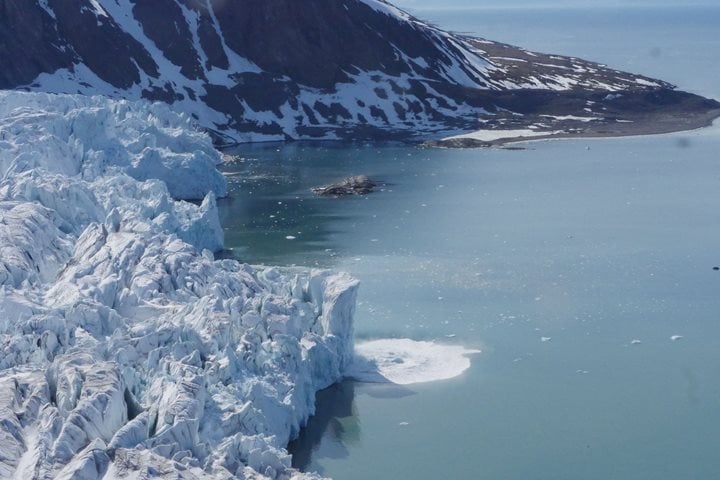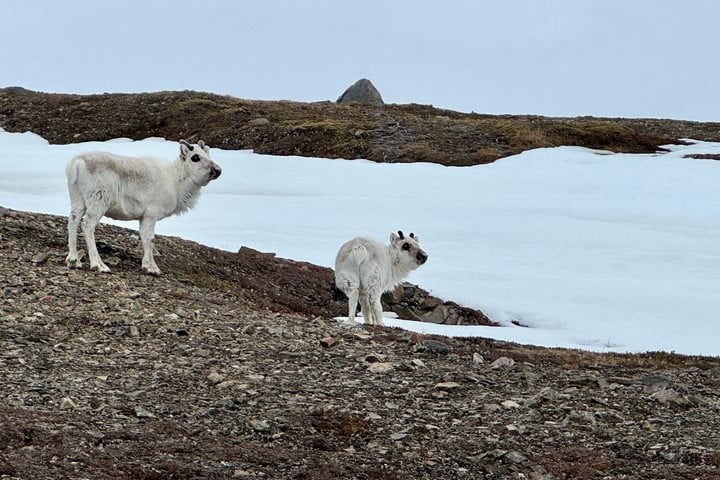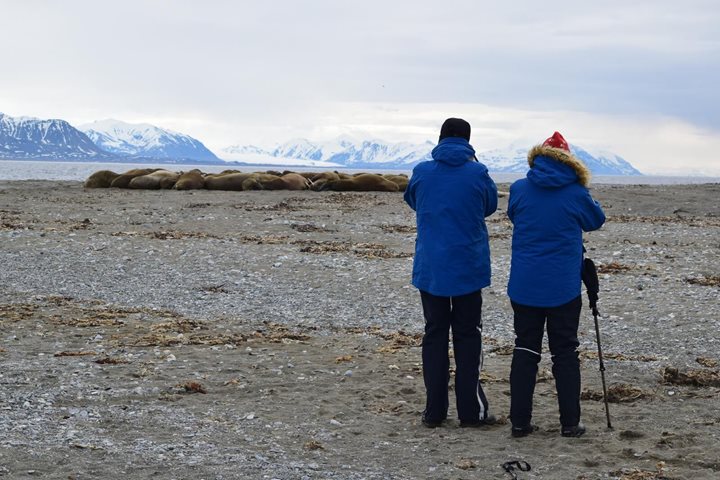We spent the entire day exploring the northern region of Svalbard’s largest island…Spitsbergen. Early this morning, National Geographic Explorer entered the enormous trifurcated fjord system known as Woodfjorden. These fjords offer some of the most impressive scenery in the entire Svalbard Archipelago with heavily eroded mountains decorated with herringbone patterns of vertical snow-filled valleys, old red sandstone sedimentary rock exposures, and glaciers. This region also typically contains a good diversity of wildlife and we were not disappointed in what we saw.
Our destination this morning was the long arm of Liefdefjord, which was named after the ship de Liefde (Dutch for Love). At its head, we encountered the enormous Monacobreen glacier, mapped and named by expeditions in 1906-07 that were organized by the Prince of Monaco. Both Zodiac and kayak operations were offered this morning and most people took advantage of both activities. The glacier has retreated and thinned considerably in the last few years. What was once a three-mile (5km) wide glacial face has now been separated into two faces as the terminal edge has backed up past the confluence of two ice runs on either side of a narrow arête, or sharp-edged line of mountains. Other glaciers can be seen nearby that have stopped flowing and no longer reach the sea and are melting away simply as static ice fields on land. Many seabirds of several species were seen feeding and just hanging out among the floating chunks of ice near the glacial face. An obvious meltwater stream flowing out from under the glacier produced a continuous upwelling near the face where thousands of kittiwakes (mostly), glaucous gulls, arctic terns, black guillemots, fulmars, arctic skuas, and a single Sabine’s gull were observed feeding on amphipods and tiny fish. All the while, we could hear thundering ice movements and occasionally see crumbling ice falling off the glacial face.
A couple beluga whales and several bearded seals were also observed in the area. One bearded seal (which actually has a moustache, not a beard) was observed on an ice floe and seemed happy to pose for photographs. Individuals of this species often develop a rust-colored face as they nuzzle about in the iron oxide laden bottom ooze and silt looking for food (Figure A). Most people seemed fascinated with the shockingly blue icebergs and bergy bits that had drifted and concentrated to one side of the fjord.
Once we made our way back out of Woodfjorden in the early afternoon, our ship headed northward. At 80º north latitude, we encountered Moffen Island, a tiny, low island with an ice-covered central lagoon. The narrow, circular band of exposed land held a wondrous sight to behold. About 80 walruses were hauled out in a tightly packed mass of flesh on the island. A few youngsters were also playing in the shallows just offshore. It was amazing to watch these behemoths shift positions, swing their tusks about, scratch themselves, and occasionally lift their heads to look about (Figure B). When we pulled away from the walrus island, our beloved vessel continued northward as we set off to look for pack ice and the interesting wildlife this ecosystem holds. Who knows how far north we may reach on this voyage?
Soon after dinner, we encountered the pack ice and immediately set to searching for wildlife. And, in short order we sighted polar bears, including a mother bear with two yearling cubs that were close to the ice edge and approachable and a lone large male far off in the distance. The mother, which wore a research collar, and her cubs slowly sauntered along on a parallel track to the ship for a while and then lay down together in a heap and ignored us. In the meantime, the distant male made a beeline toward the ship. It was amazing to watch him carefully make his way over the ice directly toward us. As he approached, the female got wind of him and the family got up and left the area. The male came right to the ship and meandered around our bow, which was parked in the ice. It would be difficult to estimate just how many photographs were made of this encounter, but it would surely be impressive (Figure C). Eventually, perhaps around midnight, the bear moved off and we then got underway again.







